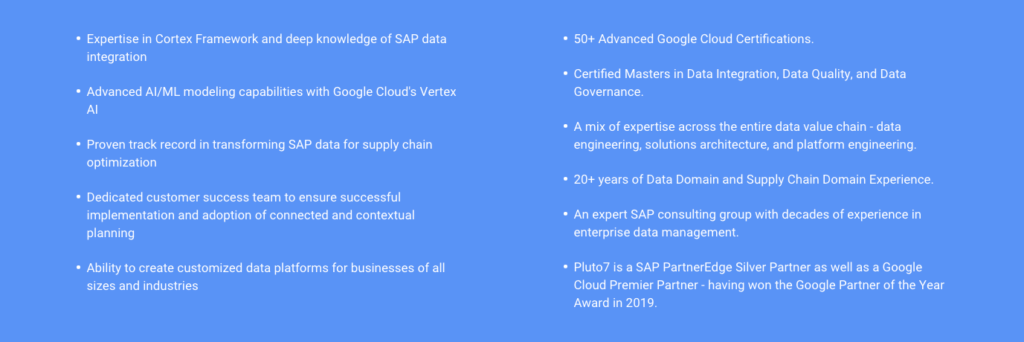
Transform Your Supply Chain Planning and Marketing Strategies with Google Cloud and SAP Integration

Transform Your Supply Chain Planning and Marketing Strategies with Google Cloud and SAP Integration
April 3, 2023 | Manju Devadas
Blog / Enhancing SAP Integrated Business Planning: Connected & Contextual Planning with External Datasets
While SAP IBP offers powerful demand planning capabilities, its demand forecasting module can be limited by several factors that impact its accuracy and effectiveness. These limitations can result in suboptimal demand forecasts, leading to inventory imbalances, production inefficiencies, and missed sales opportunities. The need of the hour is to move towards a more connected, contextual planning approach that bridges the gap between marketing, sales, and supply chain planning, providing a more accurate and comprehensive view of the business environment.
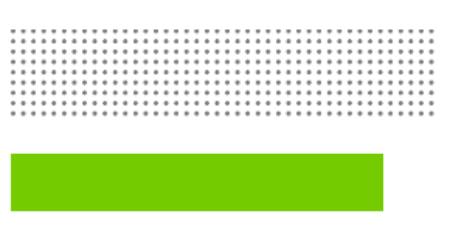
Connected, contextual planning involves integrating both internal and external data sources, such as market trends, competitor information, and economic indicators, to gain a more holistic understanding of the factors that influence demand.
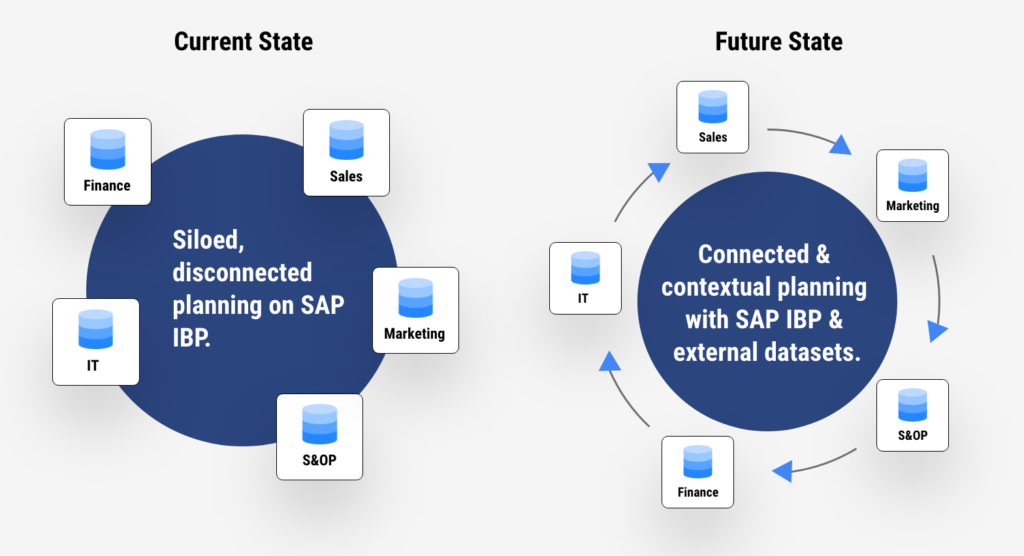
By incorporating external data sources, organizations can enhance their demand forecasting capabilities, ensuring they have access to the most up-to-date and relevant information to make informed decisions. This approach addresses the limitations of SAP IBP’s demand forecasting module, such as the limited historical data and incomplete data sets, by providing additional context and insights that can be used to supplement internal data sources.
In addition to incorporating external data sources, connected, contextual planning also emphasizes the importance of collaboration and scenario planning.
Connected, contextual planning is not a replacement for SAP IBP’s demand forecasting module but rather a complementary approach that enhances its capabilities.
By leveraging external data sources, collaborating across departments, and adopting scenario planning, organizations can develop more accurate and effective demand forecasts, leading to better inventory outcomes, optimized production processes, and increased customer satisfaction.

“Connected and contextual planning is not just a buzzword but a crucial aspect of modern supply chain management. Businesses can gain deeper insights into their operations and make informed decisions by integrating internal and external datasets and leveraging AI/ML models. The ability to anticipate changes in demand, optimize inventory levels, and manage risks in real-time is critical for building a resilient and sustainable supply chain.” – Manju Devadas, CEO, Pluto7
Connected, contextual planning refers to a data-driven approach to supply chain planning that integrates internal and external datasets to gain a more holistic view of the business environment.
One of the critical benefits of connected and contextual planning is the ability to connect marketing & sales data with supply chain data, providing a more comprehensive view of demand and inventory levels.
This is a representation of Pluto7’s Data Platform that blends data to generate real-time planning insights. Learn More.
The table below offers a detailed look at how Pluto7’s Data Platform, leveraging the power of Google BigQuery, brings significant benefits to supply chain, marketing, and sales planning. It showcases the complex queries that were once impossible, the real-time alerts and recommendations that are now achievable, and some of the actual queries organizations can perform using this advanced platform.


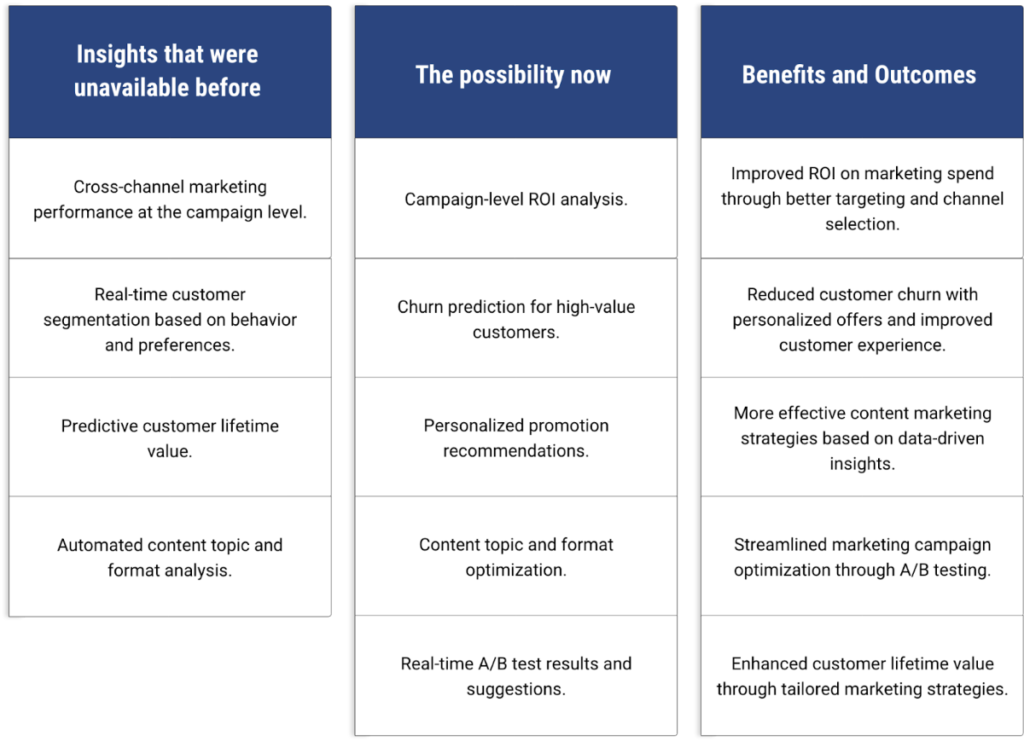

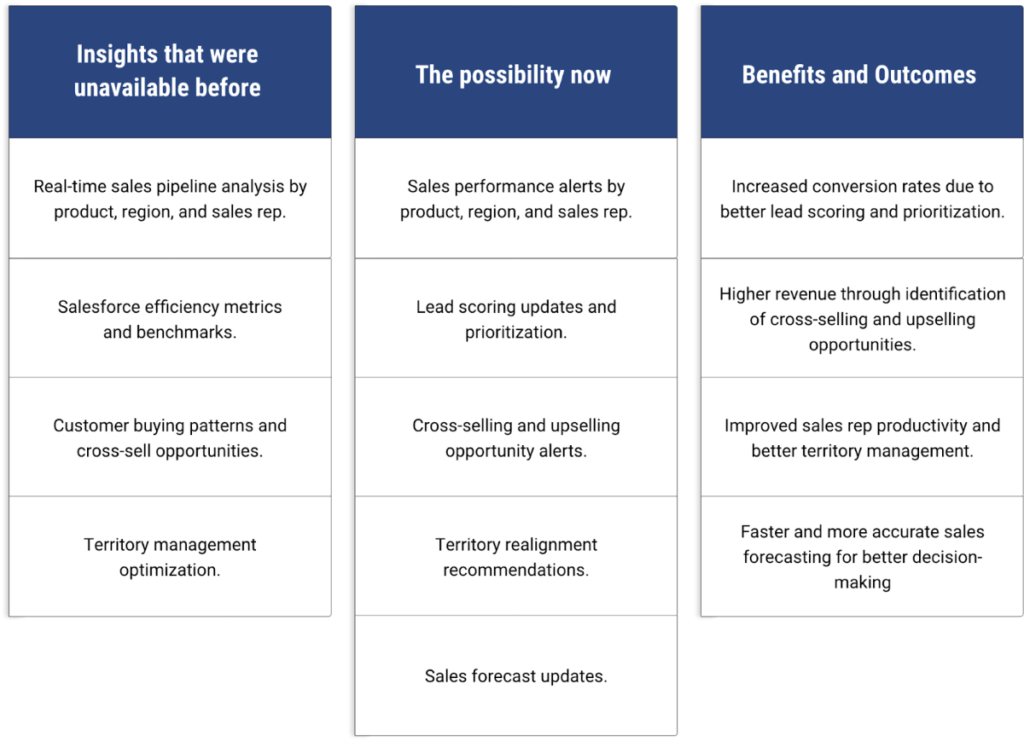

The state of inventory management today is challenging, with various reports of inventory pile-ups even after using state-of-the-art tools and advanced demand forecasting methods. The solution lies in connecting data between marketing and supply chain, allowing organizations to understand customer demand better and optimize their inventory levels accordingly.
By connecting marketing & sales data with supply chain data, organizations can achieve several key benefits.
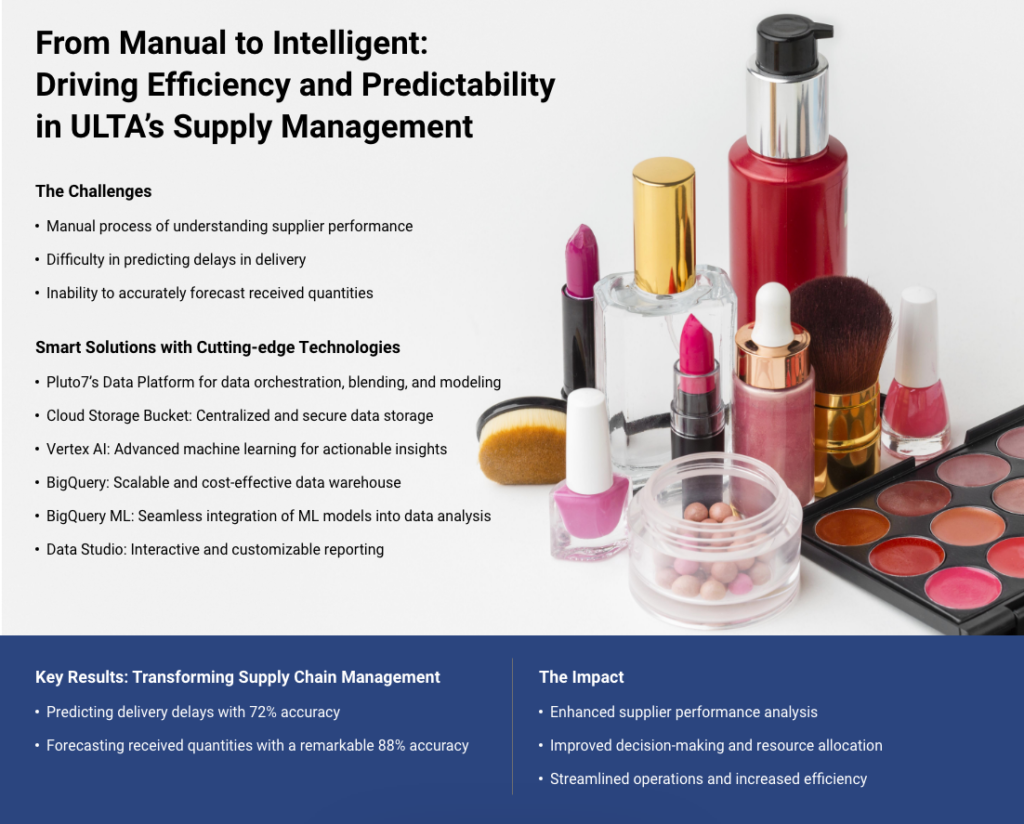
Learn more about Pluto7’s data platform solutions that can optimize your supply chain management.
To achieve some of the above benefits, organizations must connect a range of data sources, including SAP data, and external data sources, such as Google Cloud. Google Cloud offers a range of powerful data analytics tools that can be used to accelerate insights and improve decision-making.
With Google Cloud, organizations can access real-time insights from external data sources such as Google Trends, weather data, and Adtech, providing valuable context to their supply chain planning.
For example, by integrating weather data into their supply chain planning, organizations can anticipate changes in demand based on weather patterns and adjust their inventory levels accordingly. Similarly, by leveraging Adtech data, organizations can gain insights into customer behavior and preferences, allowing them to optimize their product offerings and marketing strategies.
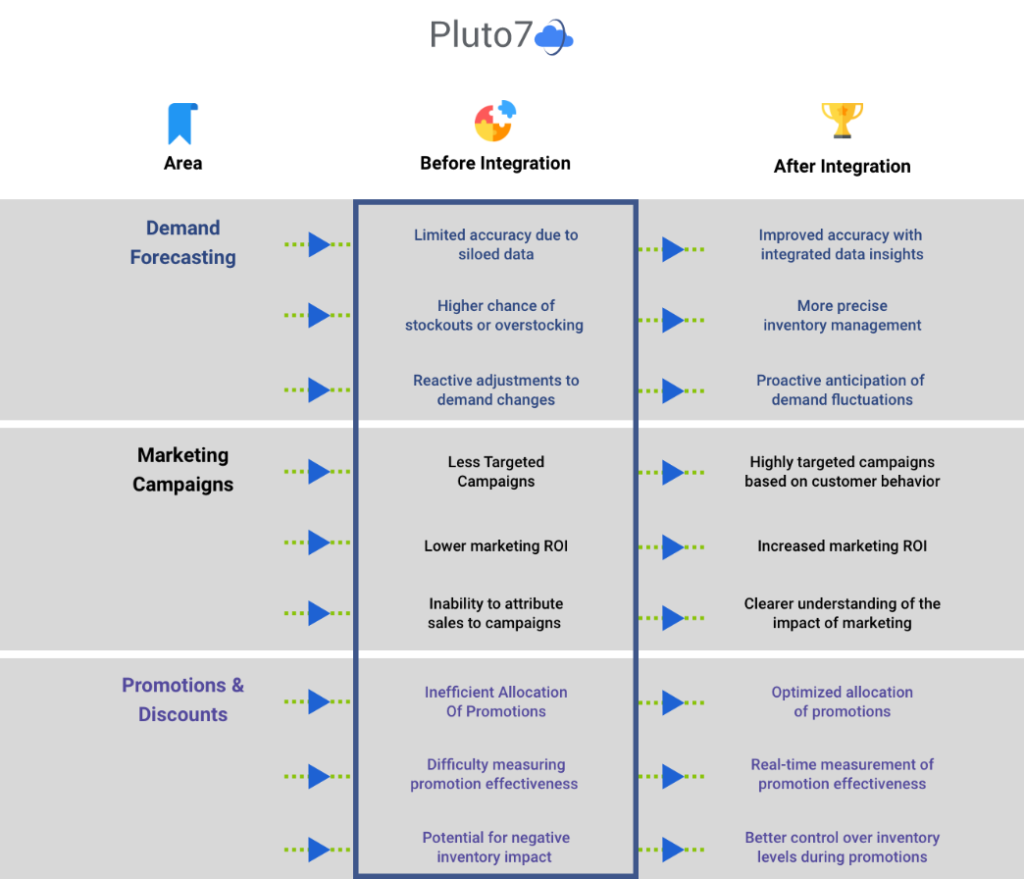
Integrating marketing and sales data with supply chain data is crucial for businesses to optimize their processes and drive better outcomes. By blending 1st party, 2nd party, and 3rd party data, companies can achieve more accurate forecasting, improve inventory management, and enhance demand sensing.
1st party data |
2nd party data |
3rd party data |
| This is data collected directly from a company’s customers and prospects. It includes information gathered from website analytics, CRM systems, and customer feedback. This data is invaluable, providing insights into customer preferences, behavior, and purchase history. | This data is collected from a company’s partners or affiliates. For example, a retailer may share their customer data with a supplier to facilitate better collaboration and coordination. This data can provide insights into a broader customer base and inform joint marketing efforts. | This data is purchased or licensed from external sources, such as data providers or market research firms. It can include demographic, psychographic, or behavioral data, which can help businesses understand their target audience better. |
Connecting marketing and sales data with supply chain data enable businesses to harness the power of advanced analytics to:
Integrating marketing, sales, and supply chain data allows businesses to achieve better inventory and forecasting outcomes. Google Cloud Platform (GCP) offers a range of tools and services to facilitate this process, including BigQuery, Data Studio, and machine learning APIs. By incorporating external datasets available on Google Cloud, businesses can enrich their internal data and drive better decision-making.
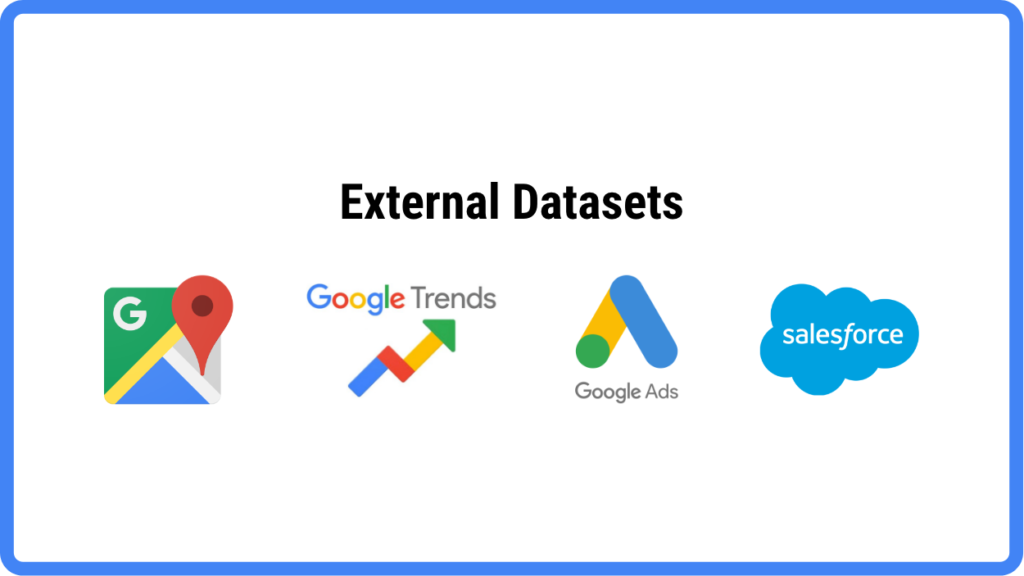
Google Cloud offers access to over 250 external datasets, which can be a game-changer for SAP users when it comes to real-time insights. These datasets cover a wide range of industries and sectors, providing valuable insights that can be used to anticipate market trends, customer preferences, and demand patterns.
By integrating these datasets with their SAP data, businesses can enhance their demand forecasting capabilities and optimize their supply chain operations.
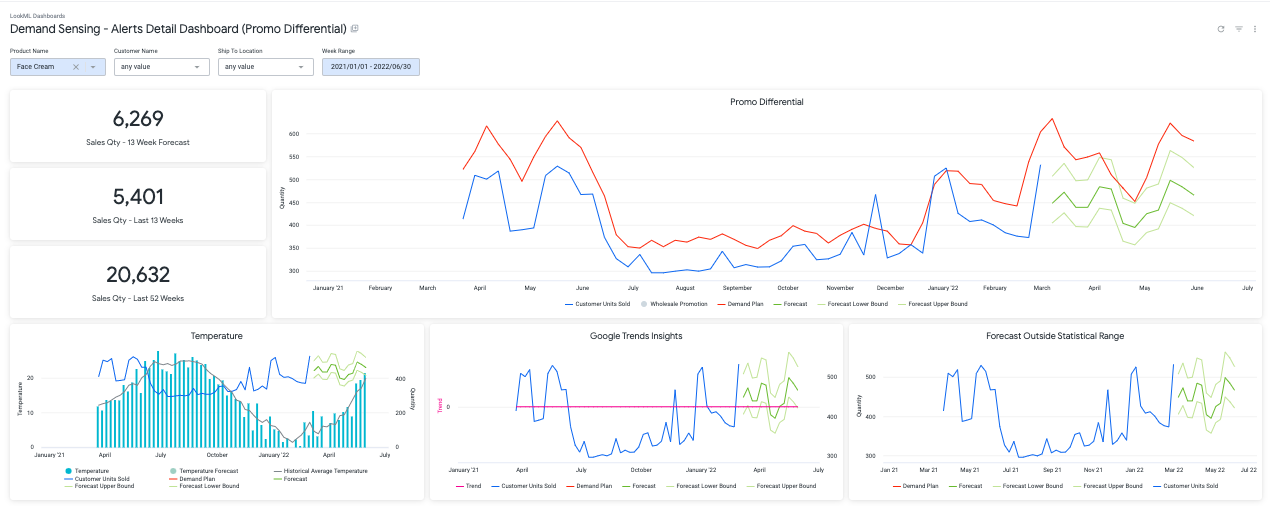
To be more specific, the platform offers a Promo Differentials dashboard that compares actual vs. forecasted sales, leveraging a range of external data sources, including Google Trends and Weather data, as well as Google Ad tech data.
By incorporating these external signals, this dashboard can highlight latent demand that may be invisible to a customer’s existing demand planning tool.
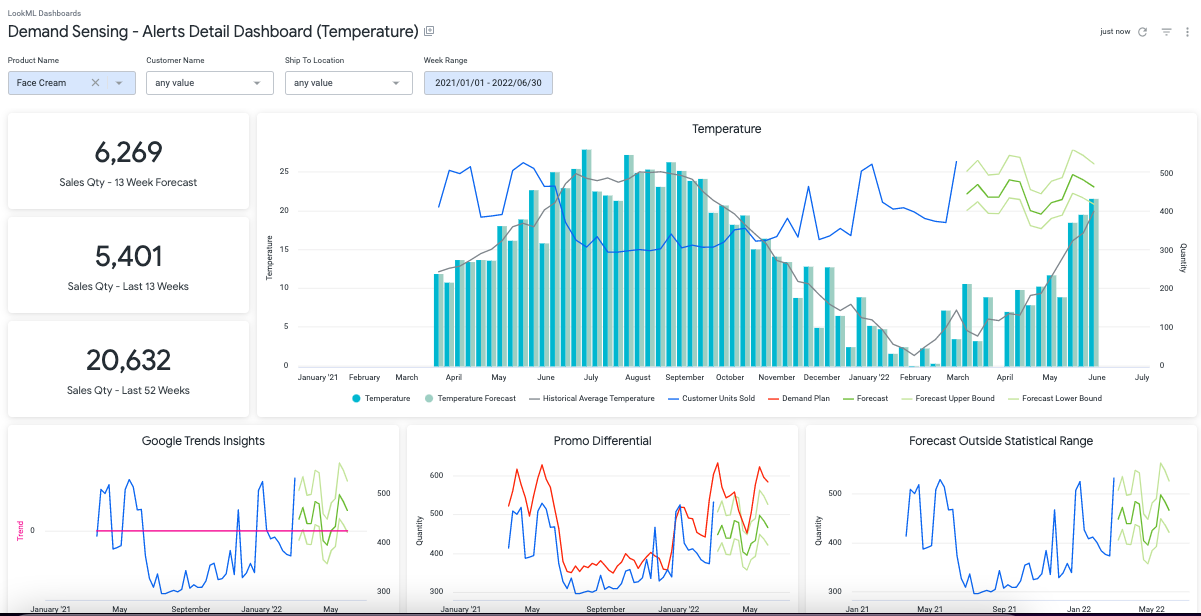
To highlight another example, here is a dashboard that leverages Google’s weather data to provide insights on sales quantity within a specific timeframe, categorized by ship-to location, product name, and customer based on temperature.
Google Adtech and Trends data offer invaluable insights into consumer behavior, preferences, and search patterns. By integrating this data with SAP systems, businesses can gain a deeper understanding of their target audience and the factors that influence their purchasing decisions.

For example, a retailer could analyze Google Trends data to identify seasonal fluctuations in demand for specific products, allowing them to adjust their procurement and inventory strategies accordingly. Similarly, by evaluating Google Adtech data, businesses can identify which marketing messages resonate most with their target audience, enabling them to optimize their advertising efforts and drive increased sales.
Integrating marketing analytics on BigQuery with SAP data can provide businesses with a powerful tool to gain deeper insights into their marketing performance and customer behavior.
With the release of Google Analytics 4 (GA4), businesses can collect a wide variety of data beyond just web analytics, allowing them to gain a comprehensive understanding of their customer’s behavior.

By analyzing SAP data alongside external datasets on BigQuery, businesses can gain a more comprehensive understanding of their customers’ behavior and preferences. This enables them to create more targeted campaigns and messaging, resulting in increased engagement and conversions.
The sheer ability to combine data from various sources such as social media conversations, search trends, and geospatial data, allow businesses to gain a more comprehensive understanding of their customers’ behavior and perform in-depth analysis.
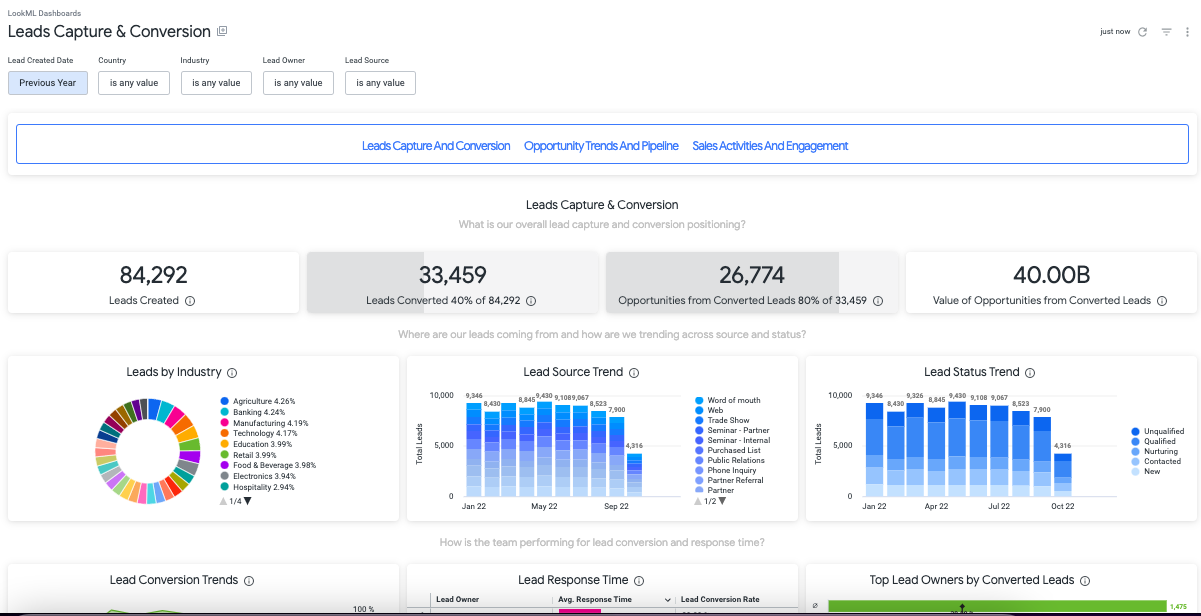
For example, a business may be running multiple marketing campaigns across different channels, such as social media, email marketing, and paid search. By analyzing the leads generated from each of these campaigns, they can identify which channels are performing the best and allocate resources accordingly.
Leveraging tools like BigQuery Machine Learning (BQML) can enable businesses to perform more sophisticated analysis of their marketing data, helping them identify the most effective campaigns and optimize their budget allocation accordingly.
By creating predictive models that forecast the impact of different marketing scenarios on conversion rates and revenue, businesses can gain laser-sharp insights into customer behavior and preferences.
They can then segment customers based on purchasing behavior, demographics, and other factors, enabling them to create targeted marketing campaigns that increase engagement and conversions.

Background
Tacori leveraged data from various sources, including Google Analytics, BigQuery, and SAP, to gain insights into customers’ behavior and preferences. They analyzed this data to identify trends and patterns that informed more effective marketing strategies and optimized their supply chain operations.
Real-time Data Analysis in Action
By analyzing real-time market movements and customer behavior using data from Google Analytics, BigQuery, and SAP, Tacori was able to shape demand and reduce pressure on inventory.
Tacori monitored customer search queries, website traffic, and social media engagement to identify which products were trending and in high demand. This allowed them to adjust their inventory levels and production schedules accordingly, ensuring they had enough inventory to meet customer demand without overstocking.
For example, if Tacori noticed that a particular product was trending on social media and generating high levels of engagement, they could adjust their inventory levels and production schedules to ensure that they had enough inventory to meet customer demand. By doing so, they were able to avoid stockouts and lost sales while reducing pressure on their inventory.
Additionally, by continuously monitoring customer behavior and preferences, Tacori was able to create new products and refine their existing product lines, which helped to drive increased revenue and improve their overall customer experience.
Learn more about Tacori’s Supply Chain Data Transformation Practices
GA4’s ability to collect a wide variety of data enables businesses to gain a more detailed understanding of their customer’s journey from awareness to conversion.
This data can be analyzed alongside SAP data on BigQuery to identify areas of opportunity and optimize campaigns accordingly, resulting in increased conversions and revenue.
With a deeper understanding of customer behavior and preferences, businesses can create more effective marketing strategies that resonate with their target audience.

Retailers and CPG companies can use external data sources to plan effective promotions that resonate with their target customers. By analyzing social media conversations, search trends, and purchasing data, they can identify the products, messaging, and channels that will drive the most engagement and sales.
Example:
A retailer uses social media conversations and purchasing data to plan a promotion for a new line of vegan snacks. They identify the messaging and channels that will resonate most with their target customers and adjust their inventory levels accordingly.


The impact of real-time events on sales is a critical factor in the retail and CPG industry. By analyzing external data sources such as social media conversations and news trends, retailers and CPG companies can understand how events such as NBA games, concerts, and holidays affect their sales. They can then adjust their promotions and inventory levels accordingly.
Example:
A CPG company analyzes search trends and social media conversations during a major sports event to identify the products that are most in demand. They adjust their inventory levels and promotions accordingly, resulting in a significant increase in sales.


Launching a new product is a crucial moment for retailers and CPG companies. By leveraging external data sources, they can identify the trends and behaviors driving demand for similar products. This information can help them create effective marketing campaigns, optimize pricing strategies, and plan inventory levels.
Example:
A retailer leverages external data sources to launch a new line of eco-friendly cleaning products. They analyze search trends, Adtech data, and social media conversations to identify the messaging and channels that will resonate most with their target customers, resulting in a successful launch.


Consumer behavior is constantly evolving, and retailers and CPG companies must stay on top of the latest trends to remain competitive. By analyzing external data sources such as social media conversations and search trends, they can identify emerging consumer behavior patterns and adjust their marketing, promotions, and product offerings accordingly.
Example:
A CPG company analyzes Google trends to identify the rising popularity of plant-based diets. They adapt their product offerings and marketing campaigns accordingly, increasing sales.


Retailers and CPG companies can gain a competitive advantage by leveraging external data sources to gain insights into their competitors’ strategies, promotions, and pricing. By monitoring their competitors’ social media conversations, website traffic, and search trends, they can identify areas of opportunity and make data-driven decisions on how to adjust their own strategies accordingly.
Example:
A retail company uses external data sources to identify its competitors’ most popular products and adjust its own product offerings to capitalize on the trend.


External data sources such as geospatial data and weather patterns can be leveraged for location-based planning. Retailers and CPG companies can analyze this data to identify areas of high demand and adjust their inventory levels and promotions accordingly.
Example:
A retailer analyzes geospatial data to identify areas of high demand during a heatwave. They adjust their inventory levels and promotions for summer items accordingly, resulting in increased sales.


Retail and CPG companies can achieve significant cost savings and operational efficiencies by leveraging external data sources, such as shipping and logistics data, to optimize their supply chain operations. By analyzing this data, they can gain insights into their supply chain performance, identify areas for improvement, and make data-driven decisions on how to optimize their supply chain.
Example:
A retailer optimized their inventory management and transportation routes using shipping and logistics data, resulting in reduced waste, improved delivery times, and cost savings.


Retail and CPG companies can achieve significant cost savings and operational efficiencies by leveraging external data sources, such as shipping and logistics data, to optimize their supply chain operations. By analyzing this data, they can gain insights into their supply chain performance, identify areas for improvement, and make data-driven decisions on how to optimize their supply chain.
Example:
A cosmetics company leveraged Google Adtech and Trends data to sense demand for a particular product that their forecast did not show. Despite not having the product in their inventory, the company noticed a sudden increase in search trends for a specific product category on Google. By analyzing this external data source, the company identified an opportunity to quickly introduce a new product in that category.


Customer segmentation plays a crucial role in tailoring marketing and promotional strategies to meet customers’ specific needs and interests. By leveraging external data sources such as social media conversations and purchasing data, retailers and CPG companies can create more accurate customer segments based on specific interests and values.
Example:
A retail company used external data sources, including social media conversations and purchasing data, to create more accurate customer segments. By analyzing social media conversations, they identified specific topics of interest to their customers, such as sustainable fashion and ethical sourcing. They then used purchasing data to identify customers who had previously purchased sustainable or ethical products and grouped them into a new customer segment.

The process of integrating SAP data with Google Cloud’s external datasets involves several steps:
|
|
|
To fully leverage the potential of connected planning and Google Cloud’s external datasets, businesses need a data platform that serves as a bridge between SAP and Google Cloud. This platform should facilitate seamless data integration, ensuring compatibility between SAP data and the external datasets available on Google Cloud. By providing a single, unified environment for data analysis, a data platform can enable businesses to harness the power of advanced analytics and AI/ML more effectively.
|
Flexibility |
|
Data integration capabilities |
|
Deep knowledge of the Cortex Framework |
|
Proven ability to transform SAP data |
|
AI/ML capabilities |
|
Credentials with Google Cloud and SAP |
Implementing connected and contextual planning can be a daunting task, requiring a range of specialized skills and expertise. In this context, selecting the right data platform is crucial, as it serves as a bridge between internal and external data sources, enabling businesses to leverage the power of advanced analytics and AI/ML more effectively.
Before implementing connected and contextual planning, it is essential to assess the current planning landscape. This involves reviewing existing planning processes, identifying areas of inefficiency, and determining which data sources are currently being used. By understanding the current planning landscape, businesses can develop a roadmap for implementing connected and contextual planning more effectively.
To fully leverage the potential of connected and contextual planning, businesses need to identify relevant external datasets that can provide insights into their operations. This may include data from sources such as social media, weather patterns, economic trends, and more. By identifying relevant external datasets, businesses can gain a more comprehensive view of their operations, enabling them to make more informed decisions.
Data integration and governance are critical considerations when implementing connected and contextual planning. Businesses need to ensure that their data platform can seamlessly integrate internal and external data sources, ensuring compatibility and accuracy. Additionally, they need to develop robust data governance policies, ensuring that data is stored and used ethically and securely.
Implementing connected and contextual planning require a significant change in the way businesses approach planning and decision-making. Developing a robust change management strategy is essential, ensuring that all stakeholders understand the benefits of connected and contextual planning and are committed to its implementation. Additionally, businesses need to ensure that the data platform is easy to use and accessible to all users, promoting user adoption.
Choosing the appropriate data platform is vital for successfully implementing connected and contextual planning. Businesses must weigh multiple factors while selecting a data platform, including data integration capabilities, flexibility, knowledge of the Cortex Framework, proven expertise in transforming SAP data, AI/ML capabilities, and credentials with Google Cloud and SAP.
Pluto7’s Demand ML solution on SAP Business Technology Platform (BTP) provides an innovative way to combine SAP Integrated Business Planning (IBP) data with external datasets to unlock valuable insights into customer behavior, market movements, and demand spikes. This easy-to-implement solution can significantly improve order planning, marketing campaigns, sales strategies, and product development. In this section, we will discuss how to get started with Pluto7’s Demand ML solution on SAP BTP.
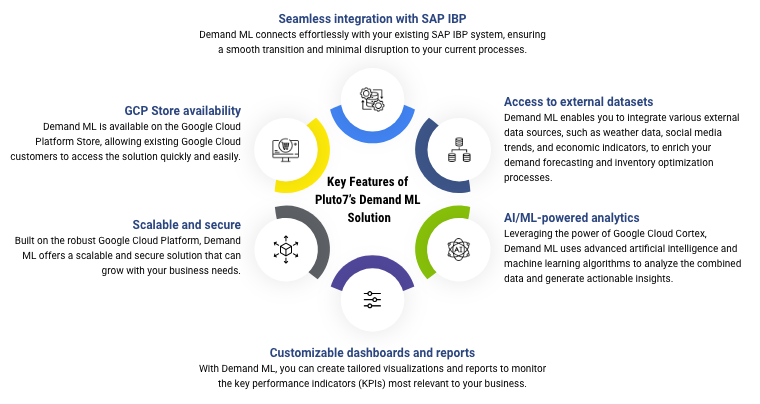
Companies that have already implemented connected and contextual planning with external datasets are experiencing a significant impact. They are able to make more informed decisions, optimize their operations, and gain a competitive edge in the market.
The key to success is selecting the right data platform and prioritizing data integration capabilities. By doing so, businesses can gain a more comprehensive view of their operations and make more informed decisions to drive success.
As a data analytics and AI and Machine Learning solutions provider, Pluto7 specializes in implementing connected and contextual planning with external datasets for SAP Integrated Business Planning.
